What's faster? Going up or Coming Down?
Suppose you are able to shoot a ball vertically straight up in the air and observe its motion (I don't know why... you might have a ballistic canon installed in the ground that allows you to do such a thing).
Assuming there are no crosswinds or other disturbances, you would expect its trajectory to be straight up, slow to a stop, and come straight back down.
But what takes longer? For the ball to reach its maximum height from when it was shot? Or for the ball to fall from its maximum height to the ground? Your intuition might suggest that it takes longer for the ball to reach max height, right? Anyway, it's a 50/50 guess I suppose.
Well, thanks to Sir Isaac Newton and the wonderful field of study called Calculus, we don't have to guess. We can work it out!
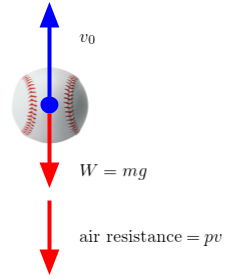
Figure 1.
To keep this relatively simple, let's assume that the only forces acting on the ball after it's been shot are retarding air resistance and the force of gravity. Suppose air resistance is linearly proportional to the ball's velocity and opposing it's motion. Thus...

And force do to gravity is simply the ball's weight (mass times acceleration due to gravity)...

The free-body diagram depicting this phenomenon is shown Figure 1 above. The blue arrow denotes the initial velocity, immediately after the ball is shot. The red arrows denote forces acting against the ball's motion.
Let's find a solution for the velocity and position of the ball as a function of time t, because we'll need both of these solutions to determine the answer to this (pointless?) question...
Now, if we sum up all of the forces on the ball in the vertical direction y, this is equal to the mass of the ball times its acceleration, according to Newton's Second Law of motion. Thus...

(Note: Σ means "Sum of")
Now we can express the acceleration of the ball as a derivative of its velocity with respect to time, i.e. a = dv/dt. Thus equation (1) becomes...

Now, equation (2) is a first-order differential equation, for which we can separate the variables as shown in equation (3)...

Integrating both sides and solving, we get...

Note: in equation (4) A = eC, an arbitrary constant of integration for the general solution. We can find a particular solution by applying the initial conditions. When the ball is launched at t = 0...

Substituting the solution for A into (4), we get...

Now that we have an expression for velocity of the ball as a function of time, we can realise that it is the derivative of its position y, i.e. v = dy/dt. And thus we can turn this into another integral problem to find the position as a function of time.

We can find the arbitrary integration constant D by again, applying the initial condition. For completeness, let's take the initial position of ball at t = 0 as  ...
...

Substituting the above express for D in to equation (6), we get...

That's a long expression, but equation (7) gives us the position of the ball at any time from when it is shot.
Now, at the top of its trajectory, when the ball reaches its maximum height, it will slow to a stop. Thus we simply need to set v = 0 to find the time  when it reaches the top...
when it reaches the top...
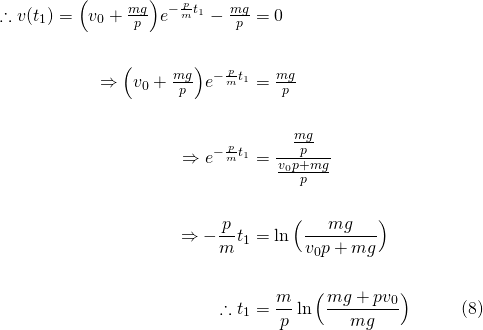
Ok, so we've got all of the equations we need in terms of symbols and algebra. Let's apply some real numbers so get can really see whether or not it is faster to go up than to come down or vice versa.
Say we have the following parameters...
- Mass of the ball m = 1kg
- Initial velocity
 = 20m/s
= 20m/s - Initial position
 = 0
= 0 - Air resistance coefficient p = 0.1
- Acceleration due to gravity g = 9.81m/s2
Therefore, from equation (5), the particular solution for velocity is...

From equation (7)...

From equation (8)...

Trajectory from equation (10) is graphed in Figure 2 along with  . The max height is y1 = 17.98m.
. The max height is y1 = 17.98m.
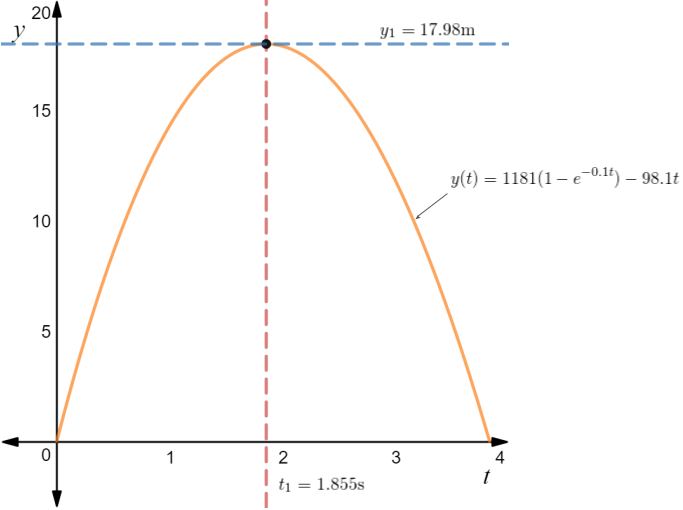
Figure 2.
It appears that the trajectory is parabolic, which implies that it is symmetrical about the vertical dashed line  .... But is it...?
.... But is it...?
Obviously the first solution to y(t) = 0 is t = 0. Unfortunately it is impossible to explicitly find the other solution from equation (10), so I've just used a "guess-and-check" approach (not very efficient - I might add) to find that y(t) crosses the horizontal axis at t = 3.83s, at which time the ball lands.
But if y(t) was symmetrical about t1, the ball would land at 2t1 = 3.71s, which is 0.12s sooner than y(t) indicates. This is shown in Figure 3 below...
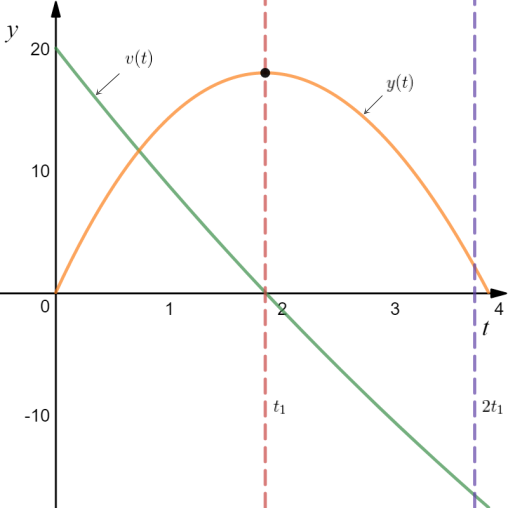
Figure 3.
Figure 3 also includes the velocity curve of equation (9). The ball lands with a speed of 17.6m/s.
So, after all of that, we can conclude it is slightly quicker for a ball to go up than it is for it to come down. This variance was due to the inclusion of air resistance in our model. If this motion was conducted in a vacuum, then the trajectory would have been parabolic, and it would have taken an equal amount of time for the ball to go up and to come down.
A comparison between a with air resistance (yellow trajectory) and without air resistance (blue trajectory) is shown in Figure 4. As you can see, the ball reaches a significantly higher height (over 2m more) and is "airborne" for a bit longer without any air resistance.
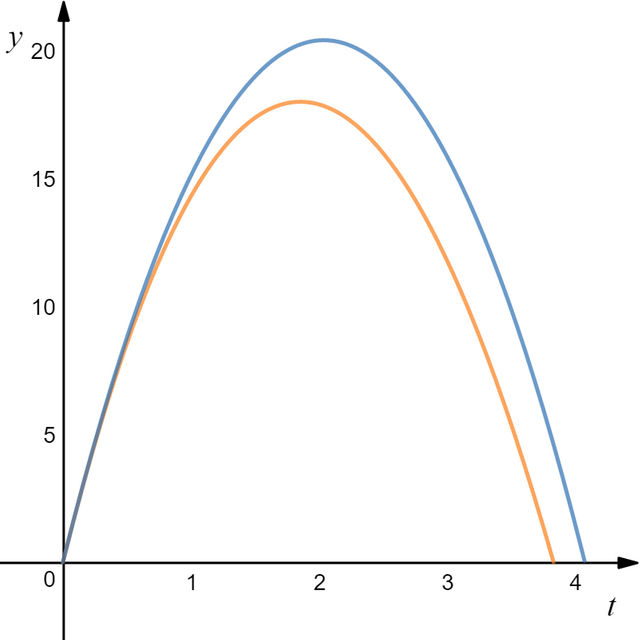
And this result makes sense, because air resistance is always acting against the motion of the ball, whereas the force due to gravity is constant and always acting in the downward motion.
So on the way up, there are 2 forces acting downwards on the ball, limiting its overall vertical rise. Whilst on the way down, there is one force in the upward direction which increases as the ball gets faster (air resistance) and one constant force in the downward direction (gravity).
On a final note, we could have also approached this entire problem by realising that equation (2) is a linear first-order equation and used an integrating factor.
Credits:
This is my worked solution from an Applied Project from the book Calculus 5th Edition by James Stewart.
All equations in this tutorial were created with QuickLatex
All graphs were created with www.desmos.com/calculator
Introduction to First Order Differential Equations
- Introduction to Differential Equations - Part 1
- Differential Equations: Order and Linearity
- First-Order Differential Equations with Separable Variables - Example 1
- Separable Differential Equations - Example 2
- Modelling Exponential Growth of Bacteria with dy/dx = ky
- Modelling the Decay of Nuclear Medicine with dy/dx = -ky
- Exponential Decay: The mathematics behind your Camping Torch with dy/dx = -ky
- Mixing Salt & Water with Separable Differential Equations
- How Newton's Law of Cooling cools your Champagne
- The Logistic Model for Population Growth
- Predicting World Population Growth with the Logistic Model - Part 1
- Predicting World Population Growth with the Logistic Model - Part 2
- What's faster? Going up or Coming Down?
First order Non-linear Differential Equations
- There's a hole in my bucket! Let's turn it into a cool Math problem!
- The Calculus of Hot Chocolate Pouring!
- Foxes hunting Bunnies: Population Modelling with the Predator-Prey Equations
Please give me an Upvote and Resteem if you have found this tutorial helpful.
Please ask me a maths question by commenting below and I will try to help you in future videos.
I would really appreciate any small donation which will help me to help more math students of the world.
Tip me some DogeCoin: A4f3URZSWDoJCkWhVttbR3RjGHRSuLpaP3
Tip me at PayPal: https://paypal.me/MasterWu
You've got our team services. [@steemsoul--@rayhanahmed--@shahanasayan--@raselhossain] Thanks for using our service.
Thanks for the post, great example of (relatively) practical calculus application.
Thank you @laxam.
So what goes up must come down but it comes down faster than it goes up
Actually, it's slightly faster to go up then it is to come down because of increasing air resistance on the way down ;)
it can not come down faster but it may come down sooner.. :-)
Congratulations! This post has been upvoted from the communal account, @minnowsupport, by masterwu from the Minnow Support Project. It's a witness project run by aggroed, ausbitbank, teamsteem, theprophet0, someguy123, neoxian, followbtcnews, and netuoso. The goal is to help Steemit grow by supporting Minnows. Please find us at the Peace, Abundance, and Liberty Network (PALnet) Discord Channel. It's a completely public and open space to all members of the Steemit community who voluntarily choose to be there.
If you would like to delegate to the Minnow Support Project you can do so by clicking on the following links: 50SP, 100SP, 250SP, 500SP, 1000SP, 5000SP.
Be sure to leave at least 50SP undelegated on your account.
You got a 1.13% upvote from @buildawhale courtesy of @masterwu!
If you believe this post is spam or abuse, please report it to our Discord #abuse channel.
If you want to support our Curation Digest or our Spam & Abuse prevention efforts, please vote @themarkymark as witness.
Does this take into effect terminal velocity? the fact that a ball can go UP MUCH faster than it can come down.
Terminal velocity occurs during free fall when an object stops accelerating towards the ground, thus reaching a constant speed called terminal velocity. This is caused by air resistance. When the force due to air resistance is equal but opposite to the force by gravity, the object will reach terminal velocity.
You can see on my graph in Figure 3 green velocity line is curved, and it subtly gets less steep as time goes on. If this ball was able to fall infinitely below the level at which it was projected, the velocity curve would eventually flatten out so that its gradient is zero. This is the terminal velocity.
This post has received a 46.68 % upvote from @fredrikaa thanks to: @masterwu.
For more information, click here!!!!
Send minimum 0.050 SBD|STEEM to bid for votes.
Do you know, you can also earn daily passive income simply by delegating your Steem Power to @minnowhelper by clicking following links: 10SP, 100SP, 500SP, 1000SP or Another amount
This post has received a 1.76 % upvote from @boomerang thanks to: @masterwu